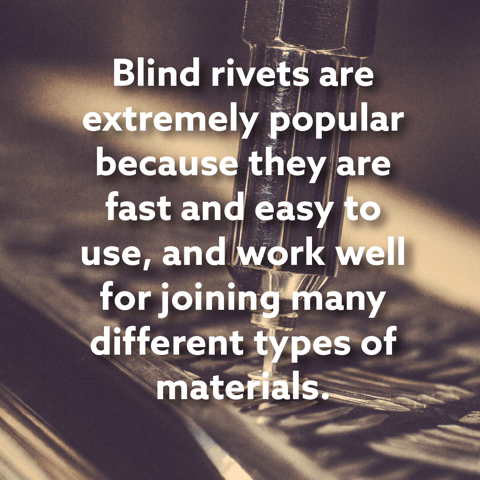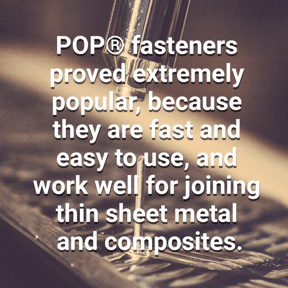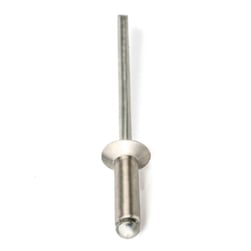
Blind rivets, pop rivets, POP® rivets—what’s the difference? In the world of fasteners, the subtle differences in hardware can make a huge difference to the success and quality of your project.
Whether you’re working on automobiles, appliances, HVAC systems, overhead doors, or lighting, here are a few things you need to know about these rivets.
What is a Blind Rivet?
A revolutionary fastener, the blind rivet is so named because it can be installed when you don’t have access to—or can’t see—the back side of the item being riveted. Prior to the invention blind rivets, the use of solid rivets and bolts meant that you needed access to both sides of a project in order to use a rivet hammer on one side and a bucking bar on the other. This complicated process made countless projects with a “blind” side impossible to complete.
Comprised of a rivet and an integrated mandrel, blind rivets are installed in a tight hole that passes through whatever material you’re riveting. A riveter is then used to pull the mandrel back while holding the rivet in place. As the mandrel is pulled back, it deforms the rivet by pushing the sides outward until the mandrel snaps. This is what forms the expanded back side of the rivet, ultimately holding the materials together.
Blind rivets are usually categorized by the material of the rivet and then the material of the mandrel. For example, you might see “aluminum/steel”, which means an aluminum rivet with a steel mandrel. These fasteners typically come in steel, stainless steel, nickel-copper alloy, and other grades of aluminum. When looking for blind rivets, we recommend always trying to match the rivet and mandrel materials to avoid corrosion and weakening in the rivet (e.g., stainless steel/stainless steel construction).

Categories of Blind Rivets
There are countless categories of blind rivets. A few of the most common are:
- Standard Blind Rivets: The most common and the least expensive, these blind rivets are not watertight and aren’t as strong as other types of fasteners.
- Sealed Blind Rivets: Similar to standard rivets, the mandrel on this rivet is completely enclosed, making it watertight.
- Multi-grip Rivets: These rivets are designed for when you don’t know how long the rivet needs to be. They’re more expensive than standard ones, but can be useful in situations where excess rivet length hanging off the back could interfere with moving parts.
Blind rivets also can have three different types of heads—round, flat, and oversized—for complete customization, no matter what type of project you’re working on.
What are Pop Rivets?
Believe it or not, “pop rivet” is typically just another name for a blind rivet. It all started in 1934, when George Tucker Eyelet Company was approached by an aircraft manufacturer that needed help developing a fastener that could be set from just one side of the material. This rivet would become the POP® rivet—named for the “popping” sound it makes during installation—which is now owned by Stanley Engineered Fastening, a division of Stanley Black & Decker.

Whether you’re looking specifically for POP® rivets or any brand of blind rivets, chances are you’ll automatically search for “pop rivets.” Why? Because the term has become more than just a brand name, much like how Velcro or Kleenex are used to describe any brand in their product category.
However, a key differentiator is that POP® rivets manufactured by Stanley Engineered Fastening is manufactured in the U.S. When you’re looking for the highest quality fastener made from the best materials available, a fastener manufactured in the U.S. should be at the top of your list.
Project Applications for Rivets
Pop rivets can fasten wood, metals, and even plastic in a blind setting on a range of projects. At home, for example, gutter construction often uses nails, which aren’t always an effective fastener because of the weight of water and other materials that can get stuck in the gutter. Pop rivets offer a better, longer-lasting alternative by attaching metal sheets together effectively.
Some of the most common pop rivet applications include:
- Attaching a sign or nameplate to a wall, where one side is inaccessible
- Attaching hinges, instead of using nails or screws
- In woodworking, because rivets provide a more sturdy construction than screws or nails
- Industrial applications, such as in the manufacturing of boats, vehicles, or aircraft, when one side of a workpiece is usually inaccessible

POP® brand rivets are often sought out by product designers for projects with unique, detailed specifications, especially when the project calls for consistency, quality, and integrity.
Blind Rivet Reliability
Overall, pop rivets are popular and reliable because they install quickly and easily, producing strong and reliable fastenings. When installed correctly, pop rivets and the installation tool won’t mar the surface of the material being joined, which means a more professional finish, too.
Whether you’re searching for a guide to blind rivets, pop rivets, or Stanley’s POP® rivets, Bay Supply is your one-stop source for blind fastener solutions. Contact our experts today for help in finding the right pop fastener for your project.





Comments